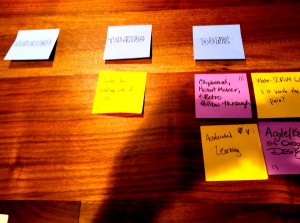Topics that made the cut:
- Clipboard, Habit Maker, & Retro follow-through
- Shared tools for helping changes from retrospectives stick
- A very large picture is put on the wall. Then covered with post-its that represent behavior changes to make (e.g., pair on a task). As team members complete the behavior change tasks, they remove the post-its. The first team member to guess what the image underneath is gets a prize.
- Behavior changes are put on a clipboard. A team member caries the clipboard and visits team members reminding them of the change. This is not a governance activity, but a reminder.
- Justin points out that a group has to get to planning actions before they can follow through on them. Considered using a technique from above as “bait” to get a team to form actionable changes from a retrospective.
- Shared tools for helping changes from retrospectives stick
- Accelerated Learning
- Framework for learning from Willem Larsen. Featured in the book-in-progress Name This Book.
- 5 Items: Alive, Fluency, Signal, Focus & Setting.
- If you take only one thing from the model, create learning environments that recognize people’s humanity.
- Noted that the “environment” and setting for retrospectives can greatly affect their effectiveness.
- Water-SCRUM-fall, is it worth the pain?
- When a program is structured very large and slow, with a staged release plan (e.g. in the first year, we’ll build the db…) but is to be run “agile” this causes pain for teams. What do to?
- Team members tend to see activities such as iteration planning, backlog management, retrospectives, demos, etc. as “stupid” and “a waste of time”.
- If you don’t have a purpose, it’s hard to know if you’re making
progress toward a goal. Team may need to set its own sub-goals, if the business isn’t providing them. - Need to get the big program focussed on results. Outcomes, not output.
- May come from fear of actually releasing. Business may not want the
changes that would come from producing a result.
- Agile/Kanban as Organiz. Design
- How can Agile and Kanban be used in organization design?
- Common models for org. design include Jay Galbraith’s Star Model. And the sociotechnical system.
- Federated models and Agile/Kanban go well together.
- Tricks for breaking out of ruts
- I’m in a rut. How do you break out of ruts?
- The Plateau Effect may help.
- What about the 5 rules of Accelerated Learning?
- Try getting others to see the same problem you see. Then you are not alone in working on the problem and not alone in the rut.
- Ruts represent a conflict of desires. Boredom comes from prevention from doing what you want to do.
- How do you use Lean for your extra-work creative projects?
- Talked a lot about Personal Kanban
- Books: Personal Kanban, Factory of One, David Starr has written a book about it, featured in WSJ.
- Tools: LeanKit, trello
- Beware the tyranny of the list. Kanban does not remove this.
- Differentiate between “holding” and “blocked” items.
- Can try to sort tasks by size. Then when presenting with time to take on a task, grab one that fits the available time.
- How about Family Kanban?
- Briefly touched on family retrospectives.
- Talked a lot about Personal Kanban
- Merging two overlapping products and technology stacks
- Merging (through acquisition) two products that overlap in both audience and functionality.
- Anti-recommendation: bigwigs decide how people will work, ignoring realities. Instead, try to bring people doing the work together early and give them a chance to solve the problem from the engineering perspective. Create value teams.
- What does success look like? What will failure look like?
- Is there common understanding of the overlap? Figure out how to make the people excited about doing the work – technical challenges? how will it build their careers?
- Recognize what’s been learned so far.
- Focus on merging people over merging technology
- What do the people stand to gain?

